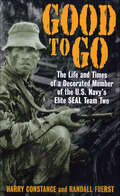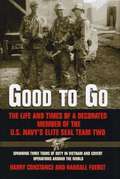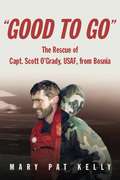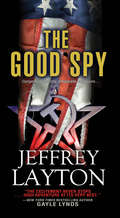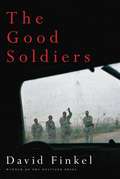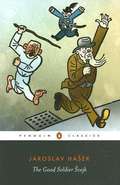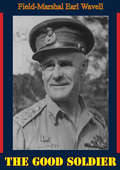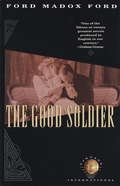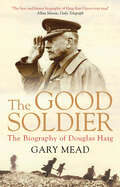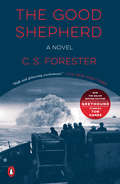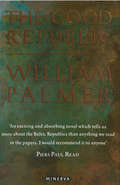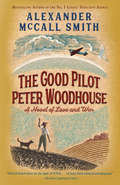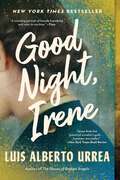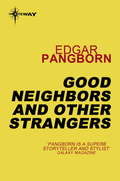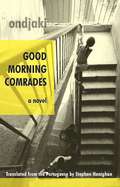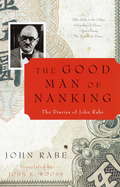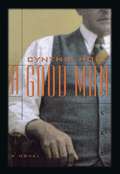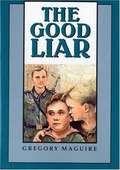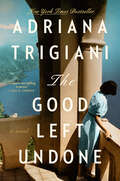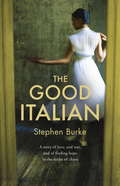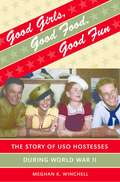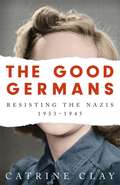- Table View
- List View
Good to Go: The Life And Times Of A Decorated Member of the U.S. Navy's Elite Seal Team Two
by Harold Constance Randall Fuerst"Fractions of a second in time. What amazing violence can be meted out in the blink of an eye."In the mid-nineteen sixties, Harry Constance made a life-altering journey that led him out of Texas and into the jungles of Vietnam. As a young naval officer, he went from UDT training to the U.S. Navy's newly formed SEAL Team Two, and then straight into furious action. By 1970, he was already the veteran of three hundred combat missions and the recipient of thirty-two military citations, including three Bronze Stars and a Purple Heart.Good To Go is Constance's powerful, firsthand account of his three tours of duty as a member of America's most elite, razor-sharp stealth fighting force. It is a breathtaking memoir of harrowing missions and covert special-ops—from the floodplains of the Mekong Delta to the beaches of the South China Sea—that places the reader in the center of bloody ambushes and devastating firefights. But his extraordinary adventure goes even farther—beyond 'Nam—as we accompany Constance and the SEALs on astonishing missions to some of the world's most dangerous hot-spots . . . and experience close-up the courage, dedication, and unparalleled skill that made the U.S. Navy SEALs legendary.Includes 8 Pages of SEAL Team Action Photos!
Good to Go!
by Harry Constance Randall FuerstIn 1966 Harry Constance became a member of the newly formed U.S. Navy SEALS TEAM II. By 1970 he was a veteran of 300 combat missions in Vietnam, had captured almost two hundred enemy prisoners, and had received 32 citations, including three bronze stars and a purple heart. In Good To Go, Constance powerfully recounts his experience during three tours in Vietnam as a member of Seal Team II, Seventh Platoon. Known as fierce warriors with amazing stealth and skill in battle, the Seals are an elite force trained to fight on sea, air, and land with sophisticated special operation warfare tactics. Made famous by Richard Marcinko's Rogue Warrior Books, here is a behind-the-scenes look at what Seal combat was really like. From the flood plains of the Mecong Delta to the beaches of the south China Sea, Good To Go takes readers on Constance's harrowing missions, along trails crisscrossed by trip wires and through dense jungles booby-trapped with live grenades. Each "Special Op" is dramatic: the Seventh Platoon sets up ambushes, infiltrates Viet Cong territory, preforms daring nighttime attacks, targets the location of high-level VC Officials, and narrowly escapes enemy fire. Constance gives an extra ordinary account of the Tet offensive, which his platoon fought from a hotel Mi Tho. But in recounting the ferocious battle of Tet, Constance shows why Seal humor and bravado always won the day. After Constance leaves Vietnam, Good To Go follows him as he plays a key role in the expansion of the Seal program. His duty training recruits for undercover clandestine Ops and going on dangerous assignments around globe - in South America hot spots and onboard nuclear submarines - reflects his inspiring dedication to the Seals. Constance's unforgettable memoir reveals the loyalty, bravery, and honor behind the Seal mystique. Packed with astonishing descriptions of the Seals real-life adventure in the deadliest of war zones, Good To Go captures the heroism and profound courage that have made the Seals legendary.
"Good to Go"
by Mary Pat KellySo perfectly executed was the mission to rescue Capt. Scott O'Grady that it amazed even the men responsible. Just five hours after radio contact was first made with Basher 52 - O'Grady's call sign the Air Force captain was safely on board the USS Kearsarge. The downed F-16 fighter pilot's rescue from a Bosnian mountainside by Col. Martin Berndt's 24th Marine Expeditionary Unit electrified the nation in June 1995 and renewed many Americans' faith in the military. This book tells the story of the mission in the words of the men who commanded, planned, and carried it out. To get the inside account, Mary Pat Kelly traveled throughout Europe to conduct more than one hundred interviews, visiting U. S. ships and bases and UN posts in Croatia and Bosnia where participants were stationed. Admiral Leighton W. Smith Jr. , commander in chief of U. S. naval forces in Europe and head of NATO forces in the Southern European theater, provides the framework with his day-to-day commentary on the efforts to find Captain O'Grady and a nearly minute-by-minute record of the rescue itself. In concert with Lt. Gen. Michael E. Ryan, commander of U. S. and NATO air forces, the admiral reveals the decision-making process that led to the "Good to Go" order. Readers then hear from the Tactical Recovery of Aircraft and Personnel (TRAP) team-the Navy and Marine Corps commanders, pilots, crew chiefs, and grunts who made it happen. Speaking for the Navy are Capt. Christopher Cole, skipper of the Kearsarge, Commo. Jerome Schill, and their staffs, from the intelligence officers to the grapes who fueled the aircraft. Captain O'Grady puts his own experiences in the context of overall events.
The Good Spy (A Yuri Kirov Thriller #1)
by Jeffrey Layton"The excitement never stops . . . high adventure at its very best." --New York Times bestselling author Gayle LyndsIn the icy waters of the northern Pacific, a top-secret mission threatens to explode into a nuclear crisis . . .A Russian military spy sub lies marooned in American waters near the U.S.-Canadian border. Yuri Kirov, a seasoned security officer, is in charge of the crew's safety--and the operation's success. His only hope is to make a death-defying underwater escape, reach shore undetected, and convince a total stranger that the fate of the world depends on helping him. For software engineer Laura Newman, it's not an easy choice. But with two Russian spies tailing them, and tensions escalating between superpowers, one wrong move could trigger unthinkable devastation. In the tradition of Tom Clancy's The Hunt for Red October, this electrifying novel of espionage is a gripping tale of danger, courage, and daring decisions. Includes an exciting excerpt from the next Yuri Kirov thriller, The Forever Spy.
The Good Soldiers
by David FinkelIt was the last-chance moment of the war. In January 2007, President George W. Bush announced a new strategy for Iraq. He called it the surge. Many listening tonight will ask why this effort will succeed when previous operations to secure Baghdad did not. "Well, here are the differences," he told a skeptical nation. Among those listening were the young, optimistic army infantry soldiers of the 2-16, the battalion nicknamed the Rangers. About to head to a vicious area of Baghdad, they decided the difference would be them. Fifteen months later, the soldiers returned home forever changed. Pulitzer Prize-winning Washington Post reporter David Finkel was with them in Bagdad, and almost every grueling step of the way. What was the true story of the surge? And was it really a success? Those are the questions he grapples with in his remarkable report from the front lines. Combining the action of Mark Bowden's Black Hawk Down with the literary brio of Tim O'Brien's The Things They Carried, The Good Soldiers is an unforgettable work of reportage. And in telling the story of these good soldiers, the heroes and the ruined, David Finkel has also produced an eternal tale-- not just of the Iraq War, but of all wars, for all time.
The Good Soldier Svejk and His Fortunes in the World War
by Cecil Parrott Jaroslav HasekIn The Good Soldier Svejk, celebrated Czech writer and anarchist Jaroslav Hasek combined dazzling wordplay and piercing satire in a hilariously revolutionary depiction of the futility of war.
The Good Soldier
by Field-Marshal Earl WavellThe Good Soldier contains the distilled wisdom of Field Marshal Wavell, collected from his numerous articles and speeches."Practically all the articles collected here were written between the two Great Wars, between 1926 and 1938; a few were written during the late war. Nearly all have been previously published, in newspapers or military journals. Whether they are worth collection and republication I must leave readers to judge. Inoculation with the deadly virus of war does not seem to confer immunity on any people or on the world as a whole for more than a very limited period. There must still be soldiers, and I fear there will still be wars in spite of UNO and ATOM. So long as war has to be studied there may be something of value in these notes of one who has studied war for close on fifty years. That is my only excuse for re-enlisting these old soldiers of my pen.Some of them may be thought old-fashioned and out of date, with little more to tell the modern student of war than would a visit to the pensioners of Chelsea Hospital. But passing down their ranks and looking them over with, I admit, an indulgent eye, I still believe that there may be something in each of these veterans, or at least in some of them, to induce thought and perhaps to sow the germ of a fresh idea. If I can claim to any merit as a soldier, it is that I have always tried to keep my mind receptive to fresh ideas, and that I have striven to present these ideas in as simple and practical a form as possible--in battle dress rather than in review order. If these old soldiers of mine can in any way help a young soldier to learn his trade--the training and handling of men in circumstances of great complexity and difficulty--they will not have come back from the Reserve in vain."--Author's Preface, 1946
Good Soldier
by Ford Madox FordAt the fashionable German spa town Bad Nauheim, two wealthy, fin de siecle couples -- one British, the other American -- meet for their yearly assignation. As their story moves back and forth in time between 1902 and 1914, the fragile surface propriety of the pre -- World War I society in which these four characters live is ruptured -- revealing deceit, hatred, infidelity, and betrayal. "The Good Soldier" is Edward Ashburnham, who, as an adherent to the moral code of the English upper class, is nonetheless consumed by a passion for women younger than his wife -- a stoic but fallible figure in what his American friend, John Dowell, calls "the saddest story I ever heard." From the Trade Paperback edition.
The Good Soldier: The Biography of Douglas Haig
by Gary MeadA balanced look at one of the most controversial commanders of World War I, using interviews with his son and new archival material to shed light onto an intensely private manPosterity has not been kind to Douglas Haig, the commander of the British Expeditionary Force on the Western Front for much of World War I. Haig has frequently been presented as a commander who sent his troops to slaughter in vast numbers at the Somme in 1916 and at Passchendaele the following year. This account reexamines Haig's record in these battles and presents his predicament with a fresh eye. More importantly, it reevaluates Haig himself, exploring the nature of the man, turning to both his early life and army career before 1914, as well as his unstinting work on behalf of ex-servicemen's organizations after 1918. Finally, in this definitive biography, the man emerges from the myth.
The Good Shepherd
by C. S. ForesterForty-eight hours on an American destroyer on the icy Atlantic during WW2.
The Good Shepherd: A Novel (Classics Of Naval Literature Ser.)
by C. S. ForesterSoon to be the major motion picture Greyhound, a WWII naval thriller of "high and glittering excitement" (New York Times) from the author of the legendary Hornblower seriesThe mission of Commander George Krause of the United States Navy is to protect a convoy of thirty-seven merchant ships making their way across the icy North Atlantic from America to England. There, they will deliver desperately needed supplies, but only if they can make it through the wolfpack of German submarines that awaits and outnumbers them in the perilous seas. For forty eight hours, Krause will play a desperate cat and mouse game against the submarines, combating exhaustion, hunger, and thirst to protect fifty million dollars' worth of cargo and the lives of three thousand men. Acclaimed as one of the best novels of the year upon publication in 1955, The Good Shepherd is a riveting classic of WWII and naval warfare from one of the 20th century's masters of sea stories.
The Good Republic
by William PalmerOpening in 1939, this novel spans 50 years and depicts the central character's life as a political emigre in a run down part of London. He is invited to return to his home city by the renascent nationalist movement where he learns the price of remaining an "innocent" in history.
The Good Pilot Peter Woodhouse: A Novel
by Alexander McCall SmithFrom the bestselling author of the No. 1 Ladies' Detective Agency series comes this meditative tale of hope and friendship during World War II, in which a young English woman, an American pilot, and a German soldier are brought together by an unlikely hero: a very sympathetic Border Collie.Val Eliot, an English city girl recruited to a farm as part of the war effort in the Women's Land Army, finds herself protecting a sheepdog named Peter Woodhouse rescued from the owner who mistreated him. When Val meets Mike, an American air force reconnaissance pilot stationed nearby, she realizes that the safest place for the little dog is alongside Mike at the base. Out of this kindness develops a love between Val and Mike that unfolds against the wartime obstacles of life-risking duty and distance. With the care and attention of the pilots, Peter Woodhouse becomes Dog First Class, the mascot of the US Air Force, boldly accompanying the officers in a Mosquito plane--until a disaster jeopardizes the future of them all. It is then that Peter Woodhouse draws Ubi, a German corporal, into their orbit, sparking a friendship that comes at great risk, but will pay the richest of rewards through the transition from war to peace time, and over the rest of their lives.
The Good Occupation
by Susan L. CarruthersWaged for a just cause, World War II was America's good war. Yet for millions of GIs, the war did not end with the enemy's surrender. From letters, diaries, and memoirs, Susan Carruthers chronicles the intimate thoughts and feelings of ordinary servicemen and women whose difficult mission was to rebuild nations they had recently worked to destroy.
Good Night, Irene: A Novel
by Luis Alberto UrreaAn Instant New York Times Bestseller This &“powerful, uplifting, and deeply personal novel&” (Kristin Hannah, #1 NYT bestselling author of The Four Winds), at once &“a heart-wrenching wartime drama&” (Christina Baker Kline, #1 NYT bestselling author of Orphan Train) and &“a moving and graceful tribute to heroic women&” (Publishers Weekly, starred review), asks the question: What if a friendship forged on the front lines of war defines a life forever? In the tradition of The Nightingale and Transcription, this is a searing epic based on the magnificent and true story of courageous Red Cross women. &“Urrea&’s touch is sure, his exuberance carries you through . . . He is a generous writer, not just in his approach to his craft but in the broader sense of what he feels necessary to capture about life itself.&” —Financial Times In 1943, Irene Woodward abandons an abusive fiancé in New York to enlist with the Red Cross and head to Europe. She makes fast friends in training with Dorothy Dunford, a towering Midwesterner with a ferocious wit. Together they are part of an elite group of women, nicknamed Donut Dollies, who command military vehicles called Clubmobiles at the front line, providing camaraderie and a taste of home that may be the only solace before troops head into battle. After D-Day, these two intrepid friends join the Allied soldiers streaming into France. Their time in Europe will see them embroiled in danger, from the Battle of the Bulge to the liberation of Buchenwald. Through her friendship with Dorothy, and a love affair with a courageous American fighter pilot named Hans, Irene learns to trust again. Her most fervent hope, which becomes more precarious by the day, is for all three of them to survive the war intact. Taking as inspiration his mother&’s own Red Cross service, Luis Alberto Urrea has delivered an overlooked story of women&’s heroism in World War II. With its affecting and uplifting portrait of friendship and valor in harrowing circumstances, Good Night, Irene powerfully demonstrates yet again that Urrea&’s &“gifts as a storyteller are prodigious&” (NPR).
Good Neighbors and Other Strangers
by Edgar PangbornIn the corner gas station, the local saloon, on the down-east farm, in the settings of EVERYDAY - there appear UNEXPECTEDLY THE ALIEN, THE WEIRD, THE MYSTERIOUSThe title story tells of one tearful stray from a herd of alien livestock which crushes most of Manhattan and causes apologetic herders to make amends. There is a shivery novelette about the abduction of a country wife by a hairy beast, and the story of a pickup truck full of mythical characters asking directions to Olympus. Then there are the ten-legged blue bugs from inner - or outer - space that can give you a dream - or a nightmare; the shadow-monkeys who have the absurd habit of following along and changing by what you think; the tiny angel that hatches from an egg; and the 'wrens' that hatch from Grandpa's beard the summer he was 106.
Good Morning Comrades
by Stephen Henighan OndjakiThe first publication in English by one of the most talented, prolific and celebrated novelists in Africa, Ondjaki's Good Morning Comrades looks at the calm before the storm of the Angolan Civil War from the perspective of a young boy. Translated from the Portuguese.
The Good Man of Nanking
by John RabeThe Good Man of Nanking is a crucial document for understanding one of World War II's most horrific incidents of genocide, one which the Japanese have steadfastly refused to acknowledge. It is also the moving and awe-inspiring record of one man's conscience, courage, and generosity in the face of appalling human brutality.Until the recent emergence of John Rabe's diaries, few people knew abouth the unassuming hero who has been called the Oskar Schindler of China. In Novemgber 1937, as Japanese troops overran the Chinese capital of Nanking and began a campaign of torture, rape, and murder against its citizens, one man-a German who had lived in China for thirty years and who was a loyal follower of Adolph Hitler-put himself at risk and in order to save the lives of 200,000 poor Chinese, 600 of whom he sheltered in his own home.From the Trade Paperback edition.
A Good Man: A Novel
by Cynthia HolzWhen his best friend is murdered in a fit of jealous rage, Izzy Schneider is compelled to reconstruct the relationship and exhume a hidden past that tests the authority of truth and weighs the burden of history. In A Good Man, critically acclaimed novelist Cynthia Holz examines Izzy’s complex lifelong friendship with Phil Lewis. Izzy escapes from Nazi Germany as a young man, leaving behind his family, who later perish in the Holocaust; Phil, a war hero, stays and fights with the partisans and saves hundreds of lives. For the rest of his life, Izzy suffers constant, unbearable guilt because he did not remain to fight like his friend Phil, and because his family is lost forever. Izzy’s daughter, Eva, tangled in the legacy of Phil’s good life and Izzy’s shame, struggles to understand her father and to make amends for a secret love affair that threatens to tear both families apart. A superb story of loss and regret, A Good Man explores history distorted through the shaded lens of time.
The Good Liar
by Gregory MaguireThe year is 1940 and France has fallen to the German army. In the village of Mont-Saint-Martin, brothers Pierre, Ren, and Fat Marcel enjoy an idyllic childhood-stealing berry tarts, playing soldiers, and holding contests to determine who of the three is the biggest and best liar. <P><P>As the small community, especially its Jewish members, begins to feel the effects of the war, Ren and Marcel form a warm but secret friendship with one of the German soldiers occupying their village. <P><P>The boys know no good can come of this friendship, but they don't realize the extent to which they have put the lives of their family and friends in jeopardy . . . until they discover that they are not the only experts at lying. In this poignant, thoughtful, and charming story, told in the form of letters to a group of schoolchildren by the now-adult Marcel, Gregory Maguire again proves his range and depth as a storyteller. <P><P>First published in Ireland, "The Good Liar" was short-listed for the 1997 Reading Association of Ireland book award and selected as one of the hundred best books of 1996 by the Young Book Trust, England.
The Good Left Undone: A Novel
by Adriana TrigianiFrom “a master of visual and palpable detail” (The Washington Post), comes a lush, immersive novel about three generations of Tuscan artisans with one remarkable secret. Epic in scope and resplendent with the glorious themes of identity and belonging, The Good Left Undone unfolds in breathtaking turns. <p><p>Matelda, the Cabrelli family’s matriarch, has always been brusque and opinionated. Now, as she faces the end of her life, she is determined to share a long-held secret with her family about her own mother’s great love story: with her childhood friend, Silvio, and with dashing Scottish sea captain John Lawrie McVicars, the father Matelda never knew. . . . <p><p> In the halcyon past, Domenica Cabrelli thrives in the coastal town of Viareggio until her beloved home becomes unsafe when Italy teeters on the brink of World War II. Her journey takes her from the rocky shores of Marseille to the mystical beauty of Scotland to the dangers of wartime Liverpool—where Italian Scots are imprisoned without cause—as Domenica experiences love, loss, and grief while she longs for home. <p><p>A hundred years later, her daughter, Matelda, and her granddaughter, Anina, face the same big questions about life and their family’s legacy, while Matelda contemplates what is worth fighting for. But Matelda is running out of time, and the two timelines intersect and weave together in unexpected and heartbreaking ways that lead the family to shocking revelations and, ultimately, redemption. <p> <b>New York Times Bestseller</b>
The Good Italian
by Stephen BurkeEnzo Secchi, harbourmaster for Massawa, Eritrea's main port, is a loyal Italian colonial servant. He takes pride in running the docks, enjoys the occasional drink with his gregarious friend Salvatore, colonel of the local Italian garrison, and listens to Caruso in his spare time. But he is lonely and when Salvatore suggests he find an Eritrean housekeeper to cook, clean - and maybe share his bed - Enzo takes the plunge and advertises. Salvatore's own tastes run to the young and nubile, but Enzo surprises himself by choosing Aatifa, a sharp-tongued woman in her 30s with a complicated family life, who takes the job as a last resort. What neither of them had counted on was falling in love.But it is 1935, Fascism is on the rise, and Mussolini does not intend Eritrea to remain a backwater for long. Italian forces bent on invading Ethiopia begin arriving at the port. And with them come new laws - including one forbidding 'Relationships of a Conjugal Nature' with Eritrean women . . .Meanwhile, Salvatore finds himself at the head of the invasion force bound for Ethiopia. Gone are the glory days of garrison life; it is a bitter campaign, laying bare all the brutality of Italian colonial ambition. Its consequences for Salvatore, and for Enzo and Aatifa as they contrive to hide their relationship in plain sight, will change all three lives for ever.
Good Girls, Good Food, Good Fun
by Meghan K. WinchellThroughout World War II, when Saturday nights came around, servicemen and hostesses happily forgot the war for a little while as they danced together in USO clubs, which served as havens of stability in a time of social, moral, and geographic upheaval. Meghan Winchell demonstrates that in addition to boosting soldier morale, the USO acted as an architect of the gender roles and sexual codes that shaped the "greatest generation."Combining archival research with extensive firsthand accounts from among the hundreds of thousands of female USO volunteers, Winchell shows how the organization both reflected and shaped 1940s American society at large. The USO had hoped that respectable feminine companionship would limit venereal disease rates in the military. To that end, Winchell explains, USO recruitment practices characterized white middle-class women as sexually respectable, thus implying that the sexual behavior of working-class women and women of color was suspicious. In response, women of color sought to redefine the USO's definition of beauty and respectability, challenging the USO's vision of a home front that was free of racial, gender, and sexual conflict.Despite clashes over class and racial ideologies of sex and respectability, Winchell finds that most hostesses benefited from the USO's chaste image. In exploring the USO's treatment of female volunteers, Winchell not only brings the hostesses' stories to light but also supplies a crucial missing piece for understanding the complex ways in which the war both destabilized and restored certain versions of social order.
The Good Germans: Resisting the Nazis, 1933-1945
by Catrine ClayAfter 1933, as the brutal terror regime took hold, most of the two-thirds of Germans who had never voted for the Nazis - some 40 million people - tried to keep their heads down and protect their families. They moved to the country, or pretended to support the regime to avoid being denounced by neighbours, and tried to work out what was really happening in the Reich, surrounded as they were by Nazi propaganda and fake news. They lived in fear. Might they lose their jobs? Their homes? Their freedom? What would we have done in their place?Many ordinary Germans found the courage to resist, in the full knowledge that they could be sentenced to indefinite incarceration, torture or outright execution. Catrine Clay argues that it was a much greater number than was ever formally recorded: teachers, lawyers, factory and dock workers, housewives, shopkeepers, church members, trade unionists, army officers, aristocrats, Social Democrats, Socialists and Communists.Catrine Clay's ground-breaking book focuses on six very different characters: Irma, the young daughter of Ernst Thalmann, leader of the German Communists; Fritzi von der Schulenburg, a Prussian aristocrat; Rudolf Ditzen, the already famous author Hans Fallada, best known for his novel Alone in Berlin; Bernt Engelmann, a schoolboy living in the suburbs of Dusseldorf; Julius Leber, a charismatic leader of the Social Democrats in the Reichstag; and Fabian von Schlabrendorff, a law student in Berlin. The six are not seen in isolation but as part of their families: a brother and sister; a wife; a father with three children; an only son; the parents of a Communist pioneer daughter. Each experiences the momentous events of Nazi history as they unfold in their own small lives - Good Germans all.
The Good Germans: Resisting the Nazis, 1933-1945
by Catrine ClayAfter 1933, as the brutal terror regime took hold, most of the two-thirds of Germans who had never voted for the Nazis - some 40 million people - tried to keep their heads down and protect their families. They moved to the country, or pretended to support the regime to avoid being denounced by neighbours, and tried to work out what was really happening in the Reich, surrounded as they were by Nazi propaganda and fake news. They lived in fear. Might they lose their jobs? Their homes? Their freedom? What would we have done in their place?Many ordinary Germans found the courage to resist, in the full knowledge that they could be sentenced to indefinite incarceration, torture or outright execution. Catrine Clay argues that it was a much greater number than was ever formally recorded: teachers, lawyers, factory and dock workers, housewives, shopkeepers, church members, trade unionists, army officers, aristocrats, Social Democrats, Socialists and Communists.Catrine Clay's ground-breaking book focuses on six very different characters: Irma, the young daughter of Ernst Thalmann, leader of the German Communists; Fritzi von der Schulenburg, a Prussian aristocrat; Rudolf Ditzen, the already famous author Hans Fallada, best known for his novel Alone in Berlin; Bernt Engelmann, a schoolboy living in the suburbs of Dusseldorf; Julius Leber, a charismatic leader of the Social Democrats in the Reichstag; and Fabian von Schlabrendorff, a law student in Berlin. The six are not seen in isolation but as part of their families: a brother and sister; a wife; a father with three children; an only son; the parents of a Communist pioneer daughter. Each experiences the momentous events of Nazi history as they unfold in their own small lives - Good Germans all.
